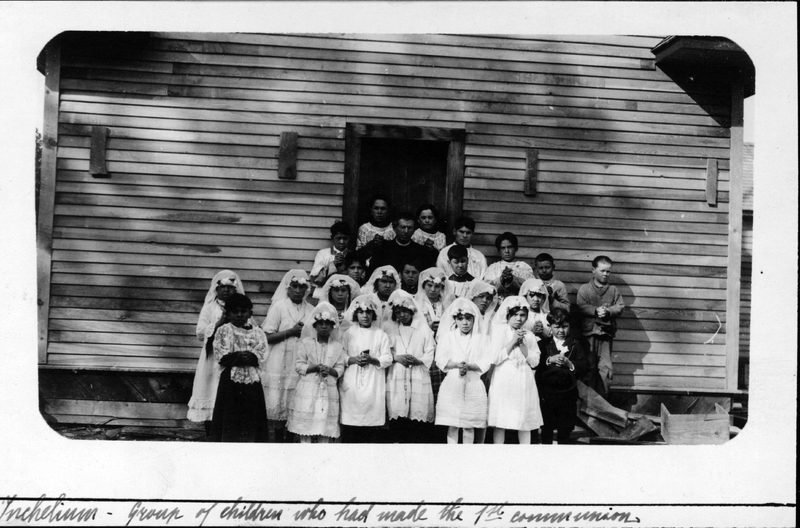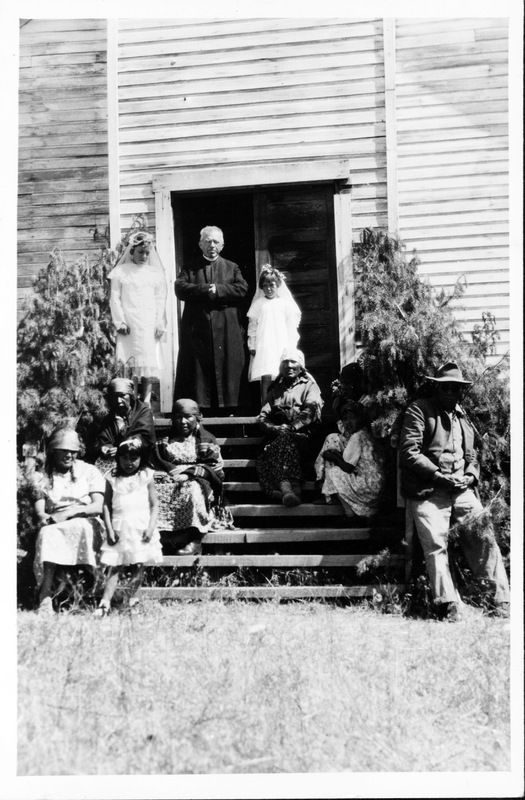Father Edward Griva

Native children with Father Griva after receiving their first communion at St. Michaels church

Father Griva at St. Rose of Lima church
In 1914, traveling to 20 different towns every month is normal for Fr. Edward Griva. Although he appears to be alone through most of his journey, he is effective and efficient. The attitude of ‘business as usual,’ is the theme of his diary. There is hardly a mention of any sort of disruption, argument, or problem that occurs in his life, roaming from mission to mission. The uniformity and structure of his life suggests that the church has been reinforcing a dependent and systemic organization on the Plateau for years previous. The hard work that goes into the initial part of building a relationship has already been done. One can imagine the difficulties that must be overcome when building a relationship with a group of people who have a different religion and culture. This burdensome time probably happened when Fr. Paul Prando was living and working on the Plateau with Native Americans. Comparing the two priests accounts of their time in the Pacific Northwest, one can see the difference of relationship between the missionaries and the Native Americans through the respect shown, the authentic culture displayed, and the territory being gained.
There is a large difference between the word ‘savage’ and the word ‘native.’ One implies a negative tone, attitude, and way of life, while the other simply describes origin. While Prando has no problem using such a discriminatory word, Griva does not use ‘savage’ once in his diary of 1914. This suggests that the white missionaries’ view of the native peoples has changed. They have been working with them for some period of time now and have ‘improved’ their way of life enough now to where they are not ‘savages’ anymore. The respect that, now, all of a sudden, the natives are deserving of, shows that the whites needed them to earn it or prove it in some way. The missionaries simply could not have respected them from the beginning. Most of the Indian’s culture, religious ceremonies, and authentic beliefs have been eradicated by now. Therefore, when the native’s culture was present, they were given the name ‘savages;’ now that most of the culture has vanished, they receive respect and are not given that name. This clear difference of respect demonstrates the white missionaries insecurity of their control over the indigenous people. Once they have cultivated enough of the Natives’ dependence on them, the insecure name calling stops. One can see how the relationship between the missionaries and the Native Americans on the Plateau has never been an equal relationship. Finally, through the development of the missions and the advancement of the land, one can see that in Griva’s time compared to Prando’s time, the territory has expanded greatly. Griva is traveling to so many places, all of which have been established and are building churches. Also, he never mentions any sort of authentic ceremony, tradition, or cultural practice being demonstrated by the Native Americans. Meanwhile, in Prando’s time, the natives still hold true to their original beliefs and practices. The vast difference that happened in 31 years is substantial.
Source: Date of entry January 1914 - June 1914; Edward Griva Collection; Oregon Province Archives of the Society of Jesus, Foley Library, Gonzaga University, Spokane, Washington.
